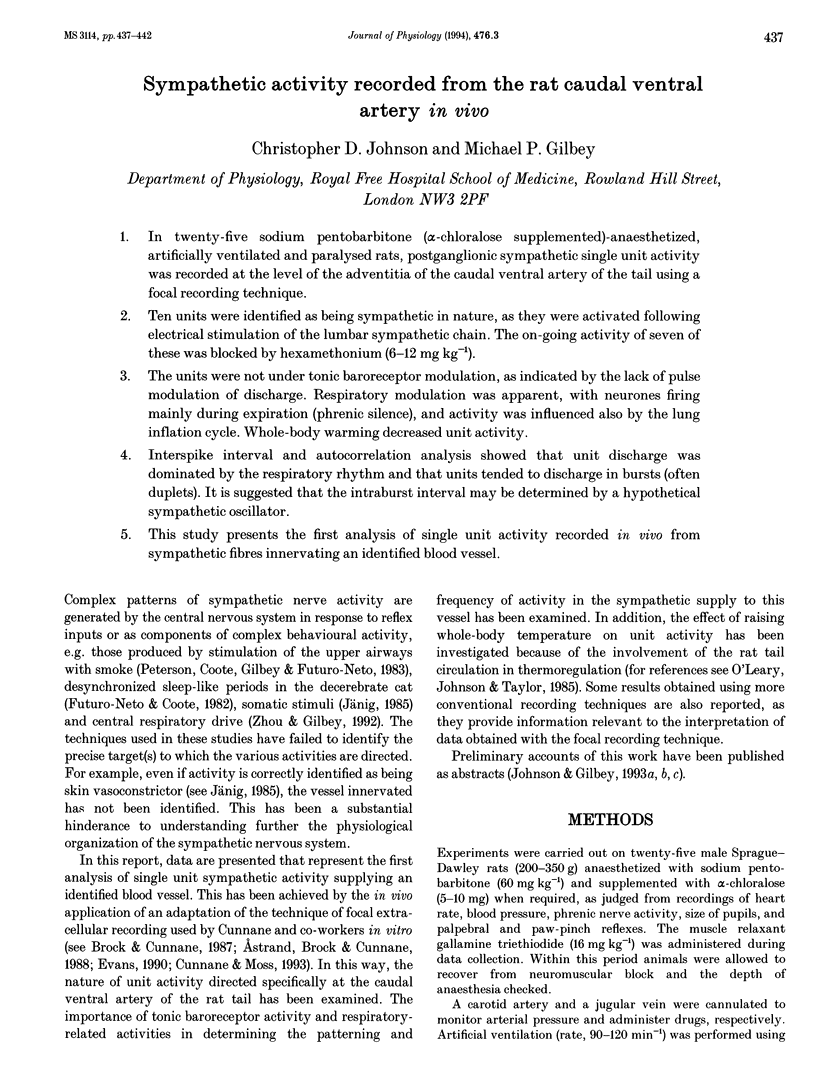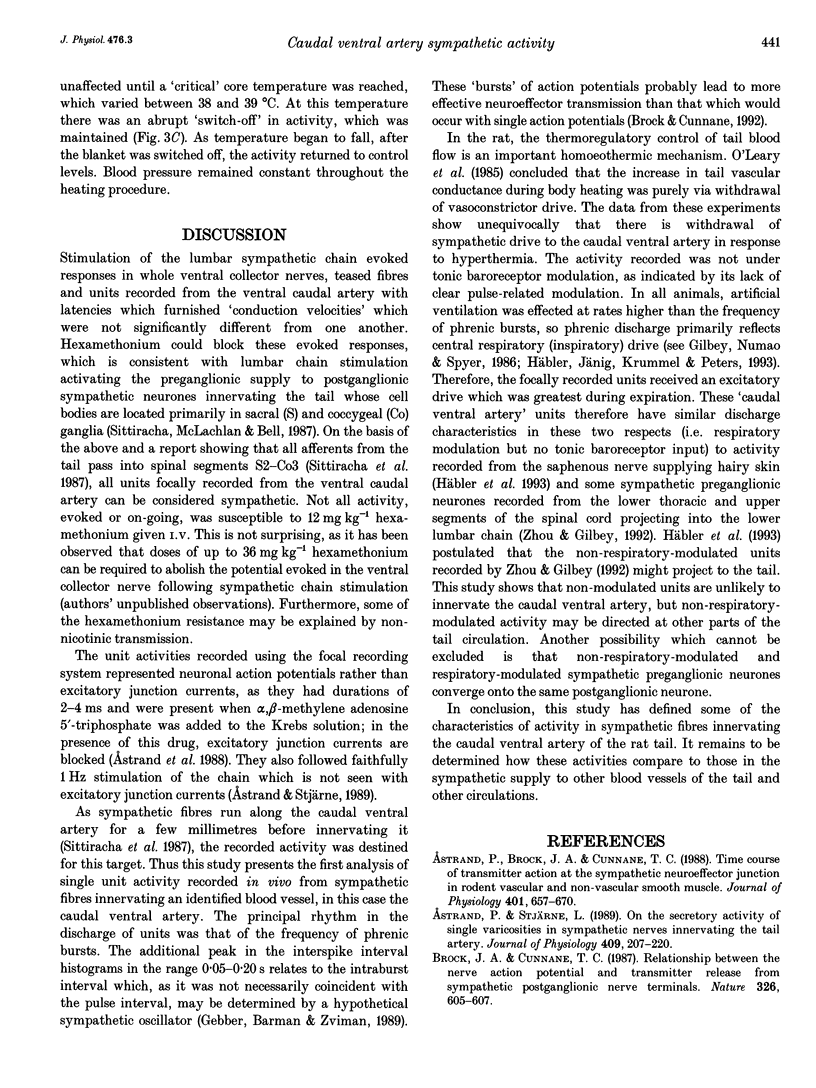Abstract
1. In twenty-five sodium pentobarbitone (alpha-chloralose supplemented)-anaesthetized, artificially ventilated and paralysed rats, postganglionic sympathetic single unit activity was recorded at the level of the adventitia of the caudal ventral artery of the tail using a focal recording technique. 2. Ten units were identified as being sympathetic in nature, as they were activated following electrical stimulation of the lumbar sympathetic chain. The on-going activity of seven of these was blocked by hexamethonium (6-12 mg kg-1). 3. The units were not under tonic baroreceptor modulation, as indicated by the lack of pulse modulation of discharge. Respiratory modulation was apparent, with neurones firing mainly during expiration (phrenic silence), and activity was influenced also by the lung inflation cycle. Whole-body warming decreased unit activity. 4. Interspike interval and autocorrelation analysis showed that unit discharge was dominated by the respiratory rhythm and that units tended to discharge in bursts (often duplets). It is suggested that the intraburst interval may be determined by a hypothetical sympathetic oscillator. 5. This study presents the first analysis of single unit activity recorded in vivo from sympathetic fibres innervating an identified blood vessel.
Full text
PDF





Selected References
These references are in PubMed. This may not be the complete list of references from this article.
- Astrand P., Brock J. A., Cunnane T. C. Time course of transmitter action at the sympathetic neuroeffector junction in rodent vascular and non-vascular smooth muscle. J Physiol. 1988 Jul;401:657–670. doi: 10.1113/jphysiol.1988.sp017185. [DOI] [PMC free article] [PubMed] [Google Scholar]
- Astrand P., Stjärne L. On the secretory activity of single varicosities in the sympathetic nerves innervating the rat tail artery. J Physiol. 1989 Feb;409:207–220. doi: 10.1113/jphysiol.1989.sp017493. [DOI] [PMC free article] [PubMed] [Google Scholar]
- Brock J. A., Cunnane T. C. Relationship between the nerve action potential and transmitter release from sympathetic postganglionic nerve terminals. Nature. 1987 Apr 9;326(6113):605–607. doi: 10.1038/326605a0. [DOI] [PubMed] [Google Scholar]
- Futuro-Neto H. A., Coote J. H. Desynchronized sleep-like pattern of sympathetic activity elicited by electrical stimulation of sites in the brainstem. Brain Res. 1982 Dec 9;252(2):269–276. doi: 10.1016/0006-8993(82)90394-8. [DOI] [PubMed] [Google Scholar]
- Gebber G. L., Barman S. M., Zviman M. Sympathetic activity remains synchronized in presence of a glutamate antagonist. Am J Physiol. 1989 Mar;256(3 Pt 2):R722–R732. doi: 10.1152/ajpregu.1989.256.3.R722. [DOI] [PubMed] [Google Scholar]
- Gilbey M. P., Numao Y., Spyer K. M. Discharge patterns of cervical sympathetic preganglionic neurones related to central respiratory drive in the rat. J Physiol. 1986 Sep;378:253–265. doi: 10.1113/jphysiol.1986.sp016218. [DOI] [PMC free article] [PubMed] [Google Scholar]
- Gilbey M. P., Stein R. D. Characteristics of sympathetic preganglionic neurones in the lumbar spinal cord of the cat. J Physiol. 1991 Jan;432:427–443. doi: 10.1113/jphysiol.1991.sp018392. [DOI] [PMC free article] [PubMed] [Google Scholar]
- Guyenet P. G., Brown D. L. Nucleus paragigantocellularis lateralis and lumbar sympathetic discharge in the rat. Am J Physiol. 1986 Jun;250(6 Pt 2):R1081–R1094. doi: 10.1152/ajpregu.1986.250.6.R1081. [DOI] [PubMed] [Google Scholar]
- Häbler H. J., Jänig W., Krummel M., Peters O. A. Respiratory modulation of the activity in postganglionic neurons supplying skeletal muscle and skin of the rat hindlimb. J Neurophysiol. 1993 Sep;70(3):920–930. doi: 10.1152/jn.1993.70.3.920. [DOI] [PubMed] [Google Scholar]
- Jänig W. Organization of the lumbar sympathetic outflow to skeletal muscle and skin of the cat hindlimb and tail. Rev Physiol Biochem Pharmacol. 1985;102:119–213. doi: 10.1007/BFb0034086. [DOI] [PubMed] [Google Scholar]
- O'Leary D. S., Johnson J. M., Taylor W. F. Mode of neural control mediating rat tail vasodilation during heating. J Appl Physiol (1985) 1985 Nov;59(5):1533–1538. doi: 10.1152/jappl.1985.59.5.1533. [DOI] [PubMed] [Google Scholar]
- Peterson D. F., Coote J. H., Gilbey M. P., Futuro-Neto H. A. Differential pattern of sympathetic outflow during upper airway stimulation with smoke. Am J Physiol. 1983 Sep;245(3):R433–R437. doi: 10.1152/ajpregu.1983.245.3.R433. [DOI] [PubMed] [Google Scholar]
- Sittiracha T., McLachlan E. M., Bell C. The innervation of the caudal artery of the rat. Neuroscience. 1987 May;21(2):647–659. doi: 10.1016/0306-4522(87)90150-3. [DOI] [PubMed] [Google Scholar]
- Zhou S. Y., Gilbey M. P. Respiratory-related activity of lower thoracic and upper lumbar sympathetic preganglionic neurones in the rat. J Physiol. 1992;451:631–642. doi: 10.1113/jphysiol.1992.sp019182. [DOI] [PMC free article] [PubMed] [Google Scholar]


